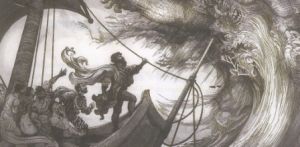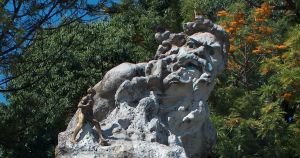Adamastor is a Greek-type mythological fictional beast representing the dangers Portuguese sailors faced when trying to round the Cape of Storms.
Etymology
The name Adamastor may come from the Greek for "Untamed" or "Untameable" (which would be correctly Adamastos) or the Latin for "imitative rival of Adam" (which would correctly be Adamaster).
Origin
Adamastor was invented by the Portuguese poet Luís de Camões in his epic poem Os Lusíadas (first printed in 1572), as a symbol of the forces of nature Portuguese navigators had to overcome during their discoveries. Camões gave his creation a history as one of the Gigantes of Greek mythology who had been spurned by Tethys, now appearing in the form of a threatening stormcloud to Vasco da Gama and threatening ruin to anyone hardy enough to pass the Cape and penetrate the Indian Ocean, which was Adamaster's domain. Adamastor became the Spirit of the Cape, a hideous phantom of unearthly pallor.
The corresponding verses in the 1572 edition.
- "Even as I spoke, an immense shape
- Materialised in the night air,
- Grotesque and enormous stature
- With heavy jowls, and an unkempt beard
- Scowling from shrunken, hollow eyes
- Its complexion earthy and pale,
- Its hair grizzled and matted with clay,
- Its mouth coal black, teeth yellow with decay. —Camões, The Lusiads Canto V.
Art/Fiction
- In The First Life of Adamastor, a novella by André Brink, the writer refashioned the Adamastor story from a 20th-century perspective.
- A popular gathering place in Lisbon is also known by the name 'Adamastor' because of the large stone statue of the mythical figure which presides over the space, which is officially called the Miradouro de Santa Catarina.
- Adamastor is mentioned in the opera L'africaine (1865) about Vasco da Gama by the composer Giacomo Meyerbeer. The slave Nelusko sings a song about Adamastor while he deliberatedly steers the ship into a storm and it sinks.
- Adamastor is also mentioned by Voltaire in his Essai sur la poésie épique.
- Adamastor also appears in the works of Victor Hugo : Les Misérables (III, Marius, chap III) and in a poem dedicated to Lamartine (Les Feuilles d'automne, chap IX).
- Alexandre Dumas, père refers the giant six times: Le Comte de Monte Cristo (chap. XXXI), Vingt ans après (chap. LXXVII), Georges (chap I), Bontekoe, Les drames de la mer, (chap I), Causeries (chap. IX) and Mes Mémoires (chap. CCXVIII).


